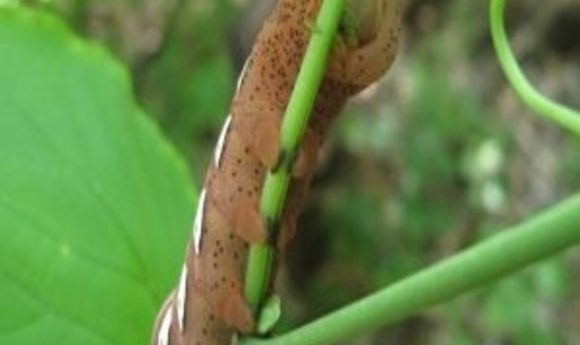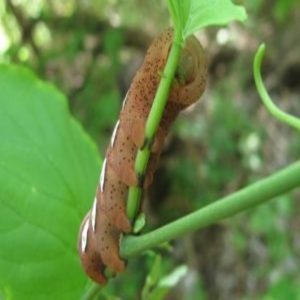Animals without gut microbiomes

A new study shows that caterpillars, unlike other herbivores, do not indulge in an interdependent relationship with microbes. Could defying this tradition of symbiosis prove advantageous for other insects and animals?

A caterpillar, Eumorpha satellitia.
Credit: Tobin Hammer, University of Colorado.
The human body harbors millions of bacteria in the gut. These resident microbes, in turn, positively affect our health, especially in aiding food digestion. This symbiotic host–microbe interaction is so widespread that researchers assumed it existed in all animals. But a recent study posted in BioRxiv, reports an unexpected finding: caterpillars lack a resident gut microbiome.
Tobin Hammer, a graduate student at the University of Colorado and lead author of the new paper, studies microbial interactions in insects. He was especially interested in caterpillars because few studies have addressed their microbiomes. “It seemed like a really good opportunity to kind of develop a new model system for microbiome research,” he said.
Hammer and his colleagues collected 124 species of caterpillars in total from the US and Costa Rica through field excursions and collaborations with caterpillar rearing experts. He extracted DNA from the fecal samples of these caterpillars and sequenced the gene coding for a part of the bacterial ribosome that has unique variants in each species in order to identify the different species in each sample.
The researchers were surprised at the huge variation in the microbial profiles between the different caterpillar samples and that the total number of microbes was much lower than that observed in other insects. Based on these findings, Hammer and team suspected that caterpillars don’t possess a unique microbial flora and that the bacteria found in their guts originate from ingested plants.
Previous isolated reports hinted that caterpillars lack resident microbiomes, but Hammer believes this is the most quantitative assessment study from different caterpillar species. “What’s different is that this is a pretty broad picture in terms of number of different species and the geographical range, taxonomic diversity of samples,” he said. The team next showed that weight gain and caterpillar development remain unaltered after antibiotic treatment, strengthening their view that bacteria do not play a role in caterpillar metabolism. Previous studies showed that caterpillars rely on digestive enzymes and a highly alkaline chemical environment in their gut to process plant material. Hammer speculates that these harsh conditions hinder the growth of microorganisms in the gut.
Melissa Whitaker, an evolutionary biologist and a postdoctoral researcher at Harvard University who was not involved with the study, finds these results especially important for understanding basic plant–animal interactions, since caterpillars belong to the second largest group of herbivores among animals.
“From the literature and the news, we get the impression that every animal has these complex interdependent symbioses,” said Hammer. He believes that this study is important in showing that not all animals depend on microbes. He suspects that there may be other animals that lack a symbiotic microbiome and is interested in understanding the evolutionary advantage, if any, in these animals.
“If you think about it from a very macro scale, it should be more advantageous to not rely on symbionts for things that are very important to your survival,” said Whitaker.
For future studies, Hammer is curious about the microbiome in butterflies. “If the caterpillar stage doesn’t necessarily have a gut microbiome, do adults?” wondered Hammer.